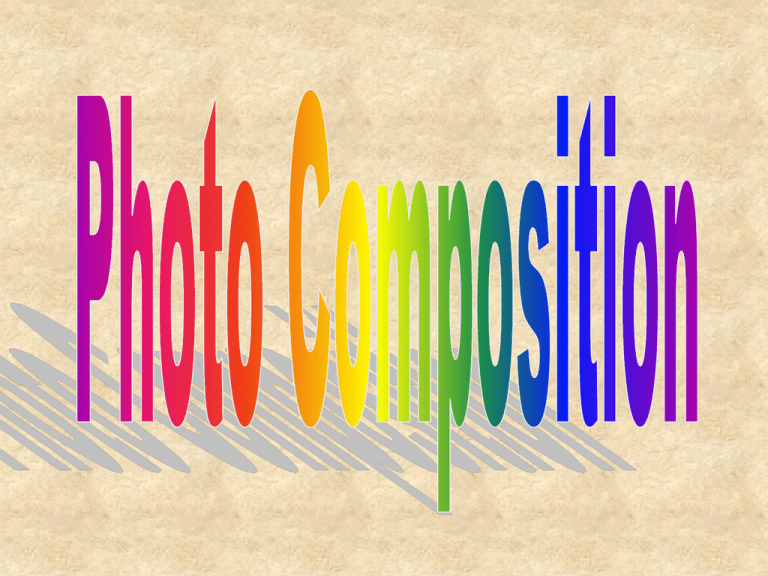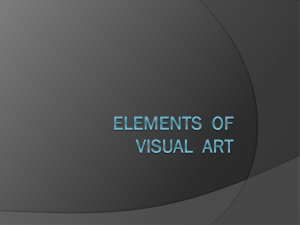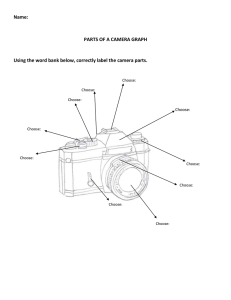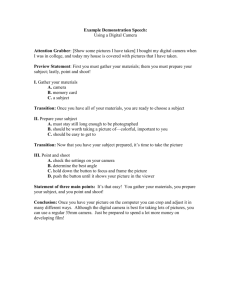Composition 1
advertisement

Photographic composition is simply the selection and arrangement of subjects within the picture area. Some arrangements are made by placing figures or objects in certain positions. Others are made by choosing a point of view.. Just moving your camera to a different position can drastically alter the composition. For moving subjects you select the best camera position and wait for the opportune moment to snap the picture when the subject is in the best location for composition. The rowboat is a recognizable object that establishes scale and helps the viewer identify the big abstract shape as the hull of a ship. Photographer: Robert Reeves KINSA/KODAK Photo Contest It is important to place figures or objects in certain positions. Figures should look into not out of the picture. Fast-moving objects should have plenty of space in front of them to give the appearance of having somewhere to go. And remember that since bright tones or colors attract attention of the eye, the most important elements of the picture should be the lightest or brightest or most colorful. Have a strong center of interest. It is usually best to have one main point of interest because a picture can tell only one story successfully. The principal subject may be one object or several. For instance, you may want to include a secondary subject, but make sure that it doesn't detract from your main subject. Whatever the main subject is, always give it sufficient prominence in the photo to make all other elements subordinate to it. Sometimes you can include a secondary subject in the picture to complement the main subject and to create a pleasing, balanced composition. When secondary subjects are included, position them in the viewfinder so that they do not detract from the main subject. If each of these two balloons appeared as the same size, the composition would be static and uninteresting. Avoid putting your center of interest in the center of your picture. Usually, if the main subject is in the middle of the picture, it looks static and uninteresting. You can often make excellent picture arrangements that have pleasing composition by placing your center of interest in certain positions according to the rule of thirds. Rule of Thirds To understand the rule of thirds, imagine two horizontal lines cutting the picture into thirds. Then imagine two vertical lines cutting the same picture into thirds vertically. The intersections of these imaginary lines suggest four possible options for placing the center of interest for a pleasing composition. When you divide a scene into thirds both vertically and horizontally, the dividing lines intersect in four places. Any of these four intersections provides a pleasing position for your center of interest. Using a low angle to photograph active people further animates them to reinforce the sense of movement. Use the best camera angle. Good pictures usually depend on selecting the proper point of view. You may need to move your camera only a few inches or a few feet to change the composition decidedly. When you want to photograph a subject, don't just walk up to it and snap the shutter. Walk around and look at it from all angles; then select the best camera angle for the picture. Outdoors, shooting from a low camera angle provides an uncluttered sky background.However, when the sky is overcast with cloud cover you'll want to shoot from a high angle and keep most or all of the sky out of the picture. Overcast skies look bleak and unappealing. The photographer pointed the camera down from a high vantage point in a nearby building to capture this unusual design of cars and pavement. The low camera angle, with a wideangle lens, helps emphasize the vastness of the ocean behind the child. Photographer: Donna Lavie Where you position the horizon can dramatically alter the mood of a photo. A high horizon seems confining, while a low horizon frees the eye. Move in close. Close-ups convey a feeling of intimacy to the viewer while long shots provide a sense of distance and depth. A close-up picture focuses your attention on the main subject and shows details that you could otherwise overlook or defines details that are too small in more distant views. Moving in close to your subject to take the picture gives the viewer the sense of being there. Photographer: Jerry Kuhaida Jr. KINSA/KODAK Photo Contest Crop carefully when you take the picture. To emphasize the subject, show it big, like the image on top, and eliminate extraneous elements. Use lines for interest and unity Use leading lines to direct attention into your pictures. Select a camera angle where the natural or predominant lines of the scene will lead your eyes into the picture and toward your main center of interest. In this case, the long neck of the horse leads your eye to the woman on the right. Photographer: Ryan Benson KINSA/KODAK Photo Contest A leading line is usually the most obvious way to direct attention to the center of interest. In this case, the rainbow leads the viewer's attention to the Acropolis. The railings of the escalators and the curves of the floors draw the viewers eye into and through the architecture of the building. Keep the background uncluttered. The background can make or break a picture. It can add to the composition and help set the mood of a picture, or it can detract from the subject if it is cluttered. Watch out for backgrounds that are more compelling than the subject. Cluttered, distracting backgrounds often spoil otherwise good pictures. Use frames to compose your pictures. For an added creative dimension, compose your pictures with an interesting foreground frame, such as a tree, a leafy branch, or a window. Try to choose a frame that links thematically with the subject such as a sailboat's rigging framing a harbor scene. Foreground frames create a sensation of depth and direct the viewer's attention to the center of interest. The photographer used the sculpture to frame the skyline and make the image more interesting. Add a natural frame to your pictures. A foreground frame can help add the feeling of depth to a picture. Draw a viewer's attention by silhouetting objects or people in the foreground. Keep an eye out for fresh approaches to make more of your pictures have lasting appeal. Sometimes you can use a colorful foreground like pretty flowers to frame your subject. Capture action when appropriate Pictures of subjects in action usually convey a feeling of excitement, so the technique you use to photograph the action will have a great deal to do with the quality and mood of your pictures. Stopping the action reveals an instant from an ongoing action. To stop action, use the fastest shutter speed allowed by the conditions. Sports are a natural for action photography. The main concern is to watch for the most opportune moment to snap the shutter as the action takes place. This is where an autowinder or motor drive comes in handy because you can take pictures rapidly. Photographer: Manuel Roberto Muro Terrazas KINSA/KODAK Action photos using a telephoto lens A telephoto lens was used to capture this dramatic picture.







